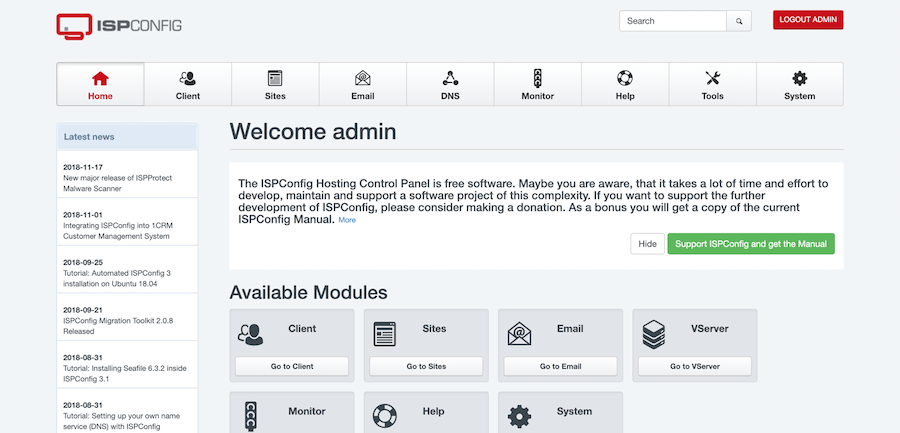How To Install ISPConfig on Ubuntu 24.04 LTS

ISPConfig stands as a powerful, open-source hosting control panel that simplifies the management of web servers. For system administrators and web hosting providers, ISPConfig offers an intuitive interface to handle multiple services, including web, email, DNS, and FTP, all from a single dashboard. As Ubuntu 24.04 LTS gains traction in the server world, combining it with ISPConfig creates a robust platform for hosting management.
This guide will walk you through the process of installing ISPConfig on Ubuntu 24.04, from initial system preparation to post-installation configuration. Whether you’re a seasoned Linux administrator or new to server management, this tutorial will equip you with the knowledge to set up a versatile hosting environment.
Overview of ISPConfig
ISPConfig is more than just a control panel; it’s a comprehensive server management solution. Developed with flexibility and scalability in mind, ISPConfig allows users to manage multiple servers from a centralized interface. Its key features include:
- Web server management (Apache and Nginx support)
- Email server configuration (including anti-spam and antivirus)
- DNS server administration
- FTP account management
- Database administration (MySQL and MariaDB)
- Firewall configuration
- Automated SSL certificate management
By leveraging ISPConfig on Ubuntu 24.04, you benefit from the latest long-term support (LTS) release of Ubuntu, ensuring stability and security for your hosting environment. The combination provides a solid foundation for both small-scale personal projects and large enterprise deployments.
Prerequisites for Installation
Before diving into the installation process, ensure your system meets the following requirements:
- A clean installation of Ubuntu 24.04 LTS
- Root access to the server
- A fully qualified domain name (FQDN) pointing to your server’s IP address
- Minimum system specifications: 1 CPU core, 1GB RAM, and 10GB storage
- Active internet connection for downloading packages and updates
It’s crucial to start with a fresh Ubuntu installation to avoid conflicts with existing software or configurations. Additionally, ensure that your server’s hostname is properly set and resolves correctly in DNS.
Before proceeding, update your system to ensure you have the latest packages:
sudo apt update
sudo apt upgrade -y
These commands refresh your package lists and upgrade all installed packages to their latest versions, providing a solid foundation for the ISPConfig installation.
Step-by-Step Installation Process
Login as Root
To begin the installation process, you’ll need to access your server via SSH. If you’re not already logged in as the root user, you can switch to root using the following command:
sudo su -
Alternatively, if you prefer to use sudo for individual commands, ensure your user has sudo privileges.
System Update and Preparation
Before installing ISPConfig, it’s crucial to ensure your system is up-to-date and has all necessary dependencies. Run the following commands:
sudo apt update
sudo apt upgrade -y
sudo apt install -y wget
These commands update your package lists, upgrade all installed packages, and install wget, which we’ll use to download the ISPConfig installer.
Setting Hostname and DNS
Proper hostname configuration is essential for ISPConfig to function correctly. Set your server’s hostname using the following command:
hostnamectl set-hostname your_hostname.yourdomain.com
Replace “your_hostname.yourdomain.com” with your actual FQDN. Next, edit the /etc/hosts file to include your hostname:
nano /etc/hosts
Add or modify the following line:
127.0.0.1 localhost
YOUR_SERVER_IP your_hostname.yourdomain.com your_hostname
Replace YOUR_SERVER_IP with your actual server IP address.
Downloading ISPConfig Installer
Now, let’s download the ISPConfig auto-installer script:
wget -O - https://get.ispconfig.org | sh -s -- --use-ftp-ports --use-php=8.2 --use-nginx --unattended-upgrades
This command downloads and executes the ISPConfig installer script with specific options:
- –use-ftp-ports: Configures FTP to use standard ports
- –use-php=8.2: Specifies PHP version 8.2 (adjust if needed)
- –use-nginx: Installs and configures Nginx as the web server
- –unattended-upgrades: Enables automatic security updates
Running the ISPConfig Auto Installer
The installer will now begin its process. It will:
- Install necessary packages and dependencies
- Configure system services (web server, database, mail server, etc.)
- Set up ISPConfig and its database
During the installation, you may be prompted to make certain choices or provide information. In most cases, the default options are suitable, but read each prompt carefully to ensure it aligns with your specific needs.
Configuring Installation Options
While the auto-installer handles most of the configuration, you may want to customize certain aspects. Here are some additional options you can consider:
--use-apache: Use Apache instead of Nginx (remove –use-nginx if using this)--use-mariadb: Prefer MariaDB over MySQL--use-certbot: Automatically configure Let’s Encrypt SSL certificates--no-mail: Skip mail server installation if not needed
To use these options, simply add them to the wget command when downloading the installer.
Completing the Installation
The installation process may take 15-30 minutes, depending on your server’s performance and internet connection. Once completed, you’ll see a message indicating that ISPConfig has been successfully installed, along with the URL and default login credentials for the ISPConfig interface.
Post-Installation Configuration
Accessing the ISPConfig Interface
After installation, you can access the ISPConfig control panel by navigating to:
https://your_server_ip:8080
Replace “your_server_ip” with your actual server IP address or domain name. Log in using the credentials provided at the end of the installation process. For security reasons, change the default password immediately after your first login.

Configuring Web, DNS, and Email Services
Once logged in, you’ll want to configure your core services:
Web Server Configuration:
- Navigate to the “System” > “Server Config” menu
- Select your server from the list
- In the “Web” tab, configure settings like PHP versions, default document root, and web server options
DNS Server Setup:
- Go to “DNS” > “Zones”
- Click “Add new zone” to create DNS records for your domains
- Configure A, MX, and other necessary records
Email Service Configuration:
- Under “Email” > “Domain”, add your email domains
- Configure spam filters, antivirus settings, and mail quotas in the “Email” > “Config” section
Security Enhancements
To further secure your ISPConfig installation:
- Enable SSL for the ISPConfig interface:
- Navigate to “System” > “Interface Config”
- Upload or generate an SSL certificate
- Enable “SSL for ISPConfig”
- Configure firewall rules:
- Use “System” > “Firewall” to set up iptables rules
- Allow necessary ports (80, 443, 22, 8080) and restrict others
- Set up automatic security updates:
- This should be enabled by default with the –unattended-upgrades option
- Verify in “System” > “Server Config” > “Updates” tab
User Management and Permissions
ISPConfig allows for granular control over user permissions:
- Create client accounts:
- Go to “Client” > “Add new client”
- Set appropriate limits and permissions
- Manage reseller accounts:
- Use “System” > “User Management” for reseller creation
- Define resource allocations and capabilities
- Configure user templates:
- Create templates in “System” > “User Management” > “Templates”
- Apply templates when creating new users for consistent permissions
Troubleshooting Common Issues
Despite careful installation, you may encounter some issues. Here are solutions to common problems:
1. Installation fails due to missing packages:
Ensure your system is up-to-date and all repositories are enabled. Run:
sudo apt update && apt upgrade -y
sudo apt install -y software-properties-common
2. Web server not starting after installation:
Check the web server logs:
tail -f /var/log/nginx/error.log # For Nginx
tail -f /var/log/apache2/error.log # For Apache
3. Unable to access ISPConfig interface:
Verify that port 8080 is open in your firewall:
ufw allow 8080/tcp
4. Email services not working:
Ensure that your DNS records are correctly set up, including MX records. Check the mail server logs:
tail -f /var/log/mail.log
If you encounter persistent issues, use the –debug option when running the installer to get more detailed output:
wget -O - https://get.ispconfig.org | sh -s -- --debug